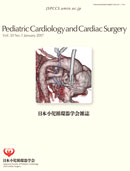Volume 33, Issue 1
Displaying 1-13 of 13 articles from this issue
- |<
- <
- 1
- >
- >|
Preface
-
2017Volume 33Issue 1 Pages 1-2
Published: January 01, 2017
Released on J-STAGE: April 03, 2017
Download PDF (125K)
Review
-
2017Volume 33Issue 1 Pages 3-9
Published: January 01, 2017
Released on J-STAGE: April 03, 2017
Download PDF (3813K) -
2017Volume 33Issue 1 Pages 10-16
Published: January 01, 2017
Released on J-STAGE: April 03, 2017
Download PDF (1174K) -
2017Volume 33Issue 1 Pages 17-23
Published: January 01, 2017
Released on J-STAGE: April 03, 2017
Download PDF (1125K) -
2017Volume 33Issue 1 Pages 24-35
Published: January 01, 2017
Released on J-STAGE: April 03, 2017
Download PDF (666K) -
2017Volume 33Issue 1 Pages 36-42
Published: January 01, 2017
Released on J-STAGE: April 03, 2017
Download PDF (606K)
Original
-
2017Volume 33Issue 1 Pages 43-49
Published: January 01, 2017
Released on J-STAGE: April 03, 2017
Download PDF (373K)
Case Report
-
2017Volume 33Issue 1 Pages 50-57
Published: January 01, 2017
Released on J-STAGE: April 03, 2017
Download PDF (5657K) -
2017Volume 33Issue 1 Pages 61-65
Published: January 01, 2017
Released on J-STAGE: April 03, 2017
Download PDF (1009K) -
2017Volume 33Issue 1 Pages 69-75
Published: January 01, 2017
Released on J-STAGE: April 03, 2017
Download PDF (5511K) -
2017Volume 33Issue 1 Pages 76-82
Published: January 01, 2017
Released on J-STAGE: April 03, 2017
Download PDF (6149K)
Editorial Comment
-
2017Volume 33Issue 1 Pages 58-60
Published: January 01, 2017
Released on J-STAGE: April 03, 2017
Download PDF (179K) -
2017Volume 33Issue 1 Pages 66-68
Published: January 01, 2017
Released on J-STAGE: April 03, 2017
Download PDF (2209K)
- |<
- <
- 1
- >
- >|
